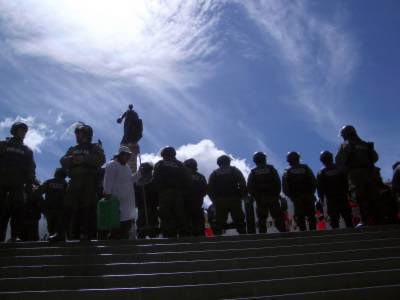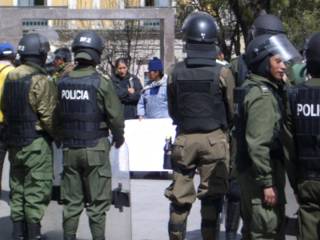El Hueco
The Following Was Posted Friday, June 10, 2005
From Last Year’s Truce to This Year’s Turmoil
The protests in Plaza Murillo during the second week of August, 2004, were low key and apparently routine. On the day I was there, about 40 men and women – mostly indigenous laborers, some very young – were picketing in the center of the plaza. There was no loud speaker or music or chants; everyone was just standing around as if waiting for something to happen. Protestors would come and go, making their way through the ring of police, who blocked them from view of traffic and passersby. The facades of Congress and the Presidential Palace adjacent to the plaza were unobstructed and seemed very business-as-usual. In the center of the plaza, protestors quietly held their turf, and the police, though dressed in riot gear, did not assume an otherwise threatening posture. This was my encounter with Bolivia’s low-key but tense status quo in 2004, one of protests and labor actions like the air traffic controller strike that had diverted my flight to Cochabamba (see October 2 below).
This week's confrontations mark the end of an 18-month truce in Bolivia’s “gas war” which resulted in 67 deaths and the resignation of President Lozado. His contracts with multinationals to develop Bolivia’s very large natural gas reserves had enraged left-leaning Bolivians who favor nationalization of the oil and gas industry. Carlos Mesa succeeded Lozado and was able to establish a period of dialogue and debate. But now that truce is faltering, and President Mesa is announcing his resignation after less than two years in office.
The distribution of Bolivia’s gas and oil wealth is only one of a variety of issues heating the country up. If you want to know more about this from people who understand much more than I do, go to Jim Shultz’s excellent blog.
The protests in Plaza Murillo during the second week of August, 2004, were low key and apparently routine. On the day I was there, about 40 men and women – mostly indigenous laborers, some very young – were picketing in the center of the plaza. There was no loud speaker or music or chants; everyone was just standing around as if waiting for something to happen. Protestors would come and go, making their way through the ring of police, who blocked them from view of traffic and passersby. The facades of Congress and the Presidential Palace adjacent to the plaza were unobstructed and seemed very business-as-usual. In the center of the plaza, protestors quietly held their turf, and the police, though dressed in riot gear, did not assume an otherwise threatening posture. This was my encounter with Bolivia’s low-key but tense status quo in 2004, one of protests and labor actions like the air traffic controller strike that had diverted my flight to Cochabamba (see October 2 below).
This week's confrontations mark the end of an 18-month truce in Bolivia’s “gas war” which resulted in 67 deaths and the resignation of President Lozado. His contracts with multinationals to develop Bolivia’s very large natural gas reserves had enraged left-leaning Bolivians who favor nationalization of the oil and gas industry. Carlos Mesa succeeded Lozado and was able to establish a period of dialogue and debate. But now that truce is faltering, and President Mesa is announcing his resignation after less than two years in office.
The distribution of Bolivia’s gas and oil wealth is only one of a variety of issues heating the country up. If you want to know more about this from people who understand much more than I do, go to Jim Shultz’s excellent blog.
The Following Was Posted Thursday, June 02, 2005
230 Volts of Wet Fun
Nothing tests your desire for a warm shower like the site of a shabby electric water heater built directly into a leaky shower head. Stepping into this chamber on my first morning at the hostel felt like some sort of initiation, a joke to see which rookies would be foolish enough to stand naked on a wet concrete floor and touch a contraption connected to 230 volts by ten-gauge wire and electrical tape. All I needed was a black hood and a some reconnections of the wires in unspeakable places, and the Abu Graib image would be complete.
I decided to opt for the cold shower in the next stall. A few days later, even that option fell to some sort of technical failure, and I had to settle for a bucket shower.
Eventually, I did give the electric heater a half-hearted effort. I tapped on the breaker switch and jiggled the shower head, according to directions from my fellow Habitat volunteers. People I trusted. With my life. At one point, the water in the shower head gave a mechanical moan and drew some of the electrical current from the light bulb hanging by a wire from the ceiling. I screamed twice, first from the sudden splash of hot water – way too hot – and then from the sudden ice cold water that followed. As the shower head moaned again, building up for another assault on my goose bumped skin, I killed the water pressure and used my rubber flip-flop to knock the circuit breaker on the wall to its off position. Then I used it to swat a mosquito.
Nothing tests your desire for a warm shower like the site of a shabby electric water heater built directly into a leaky shower head. Stepping into this chamber on my first morning at the hostel felt like some sort of initiation, a joke to see which rookies would be foolish enough to stand naked on a wet concrete floor and touch a contraption connected to 230 volts by ten-gauge wire and electrical tape. All I needed was a black hood and a some reconnections of the wires in unspeakable places, and the Abu Graib image would be complete.
I decided to opt for the cold shower in the next stall. A few days later, even that option fell to some sort of technical failure, and I had to settle for a bucket shower.
Eventually, I did give the electric heater a half-hearted effort. I tapped on the breaker switch and jiggled the shower head, according to directions from my fellow Habitat volunteers. People I trusted. With my life. At one point, the water in the shower head gave a mechanical moan and drew some of the electrical current from the light bulb hanging by a wire from the ceiling. I screamed twice, first from the sudden splash of hot water – way too hot – and then from the sudden ice cold water that followed. As the shower head moaned again, building up for another assault on my goose bumped skin, I killed the water pressure and used my rubber flip-flop to knock the circuit breaker on the wall to its off position. Then I used it to swat a mosquito.





